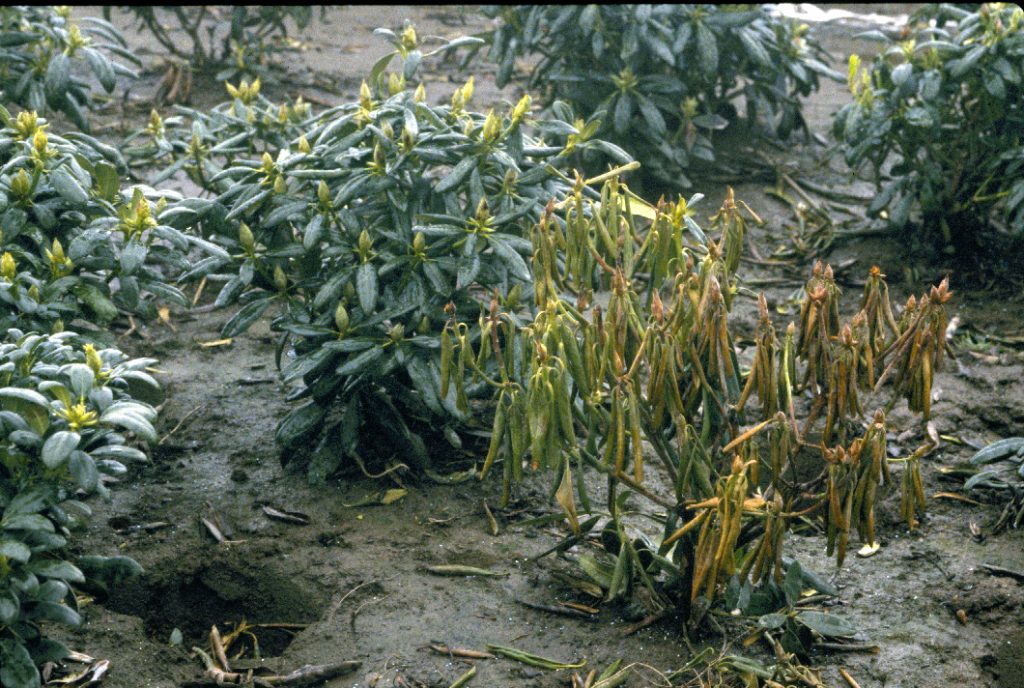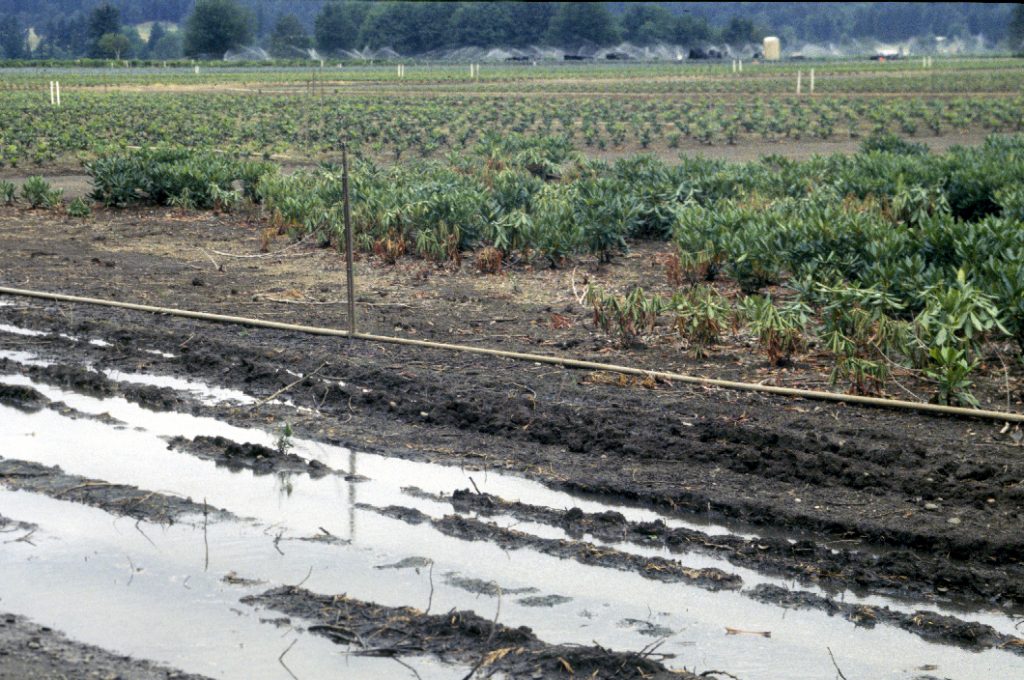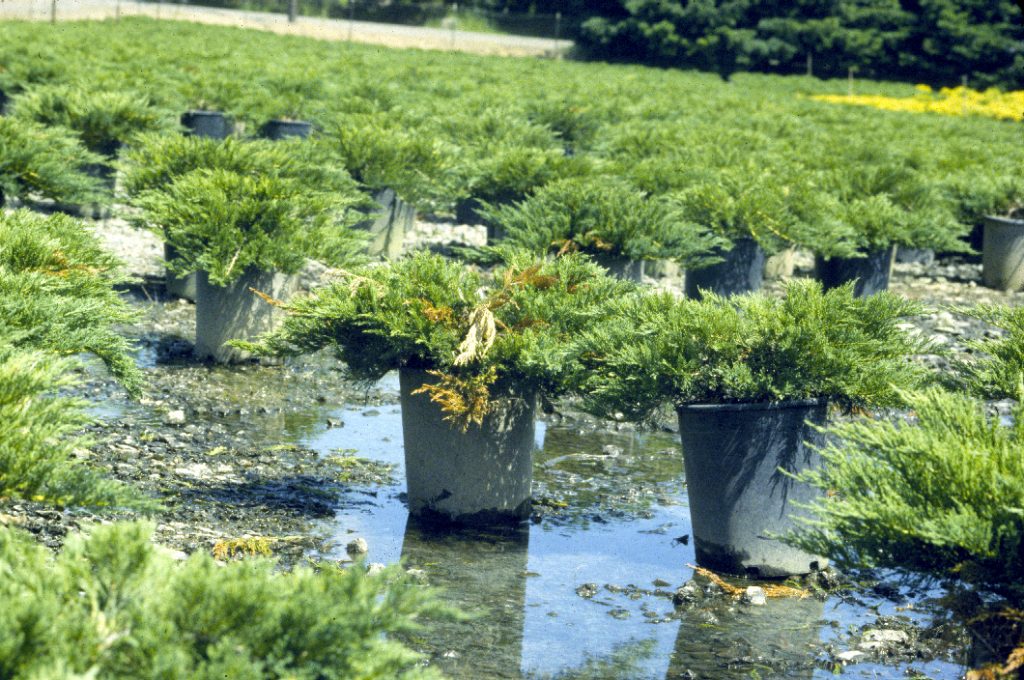How to Control Phytophthora?
Controlling measures at a glance:
• Ensure that soils, growing media, and standing areas are well drained.
• Ensure that water used for irrigation is free from Phytophthora. Cover storage tanks to prevent infection contamination from soil and plant debris. Consider the use of filters or sterilization where water is re-circulated or known to be contaminated.
• Use new pots, trays, etc. or at least treat any re-used items with a disinfectant.
• Inspect bought-in plants. If possible, have a quarantine area where bought-in stock can be held and monitored for disease development for a few weeks.
• When propagating, take cuttings from healthy plants only. Avoid taking cuttings of nursery stock close to the ground, as these could be contaminated by soil or compost containing Phytophthora.
The most important factor in controlling the threat of Phytophthora rot is good water management. Avoid prolonged saturation of the soil or standing water around the base of trees or other susceptible plants. Irrigate only as much and as often as necessary; in an orchard, keep track of the soil moisture around each tree and water only when necessary. If you irrigate trees with sprinklers, use low-angle sprinkler heads and splitters to avoid wetting the trunk and lower branches.
If using a drip system, place the emitters at least a foot away from the trunk. Avoid planting susceptible species on poorly drained or shallow soils. Water stress and/or salinity make some plant species more susceptible to infection when wetted subsequently by irrigation or rains.
For all vegetable and orchard plants, provide good soil drainage. Good soil drainage is best provided before planting. Drainage should be plentiful to the rooting depth of the plants, generally 3 to 6 feet for trees, 2 to 4 feet for shrubs, and 1 to 2 feet for bedding plants. During favorable weather you do not want the roots and crown of a plant to remain wet for the 4 to 8 hours that are required for Phytophthora to infect the plant.
Provide adequate drainage by breaking through soil compaction and hardpan. In poorly drained soils, or in an area where you know Phytophthora is present, consider planting trees and shrubs on mounds. The mounds should be 8 to 10 inches high. Planting depth after settling should be no deeper than as received from the nursery, with the upper roots near the soil level and the graft union well above the soil line.
Following are the key points that every farmer must ensure in order to control Phytophthora. The key is to be consistent and take all the steps necessary to prevent infection.
Use clean water
Water may be used in farms and nurseries to control dust, adjust earth materials to proper moisture for compaction and other purposes. Surface waters, including untreated water from streams or ponds and runoff, are known sources of Phytophthora contamination. Only uncontaminated water or water that has been effectively treated to remove or kill Phytophthora should be used for crop purposes.
Use clean materials
To prevent risks associated with Phytophthora and other invasive species, all materials need to be protected from contamination during storage and transport. Many materials, including dimensional lumber, pressure-treated wood products, and metal hardware, are free from Phytophthora because of their composition or the way they are sourced or produced. Protecting these materials from contamination maintains their no-risk status. If these same materials have been in service and are removed for reuse, they can pose a risk if they have become contaminated with soil or debris that contains Phytophthora, so additional practices are needed to mitigate this risk.
Cleaning and Sanitation
Phytophthora contamination can be present in a variety of sites and materials, including commercial nursery stock, landscaped and agricultural areas, and some infested native or restored habitat areas. Contamination can be spread via soil, plant material and debris, and water from infested areas. Arriving at the site with clean vehicles, equipment, tools, footwear, and clothing helps prevent unintentional contamination of the job site from outside sources. The objective in cleaning and sanitation is to prevent the transfer of potentially contaminated soil, roots, plant debris, or water to the job site.
All cleaning activities in this section should be carried out away from the job site, preferably in a facility that allows for capture and proper disposal of debris and contaminated water, such as a commercial vehicle washing facility or a wash-down pad.
Certified Stock
Plant only certified nursery stock from a reputable source, and choose the most resistant rootstocks or varieties available for your area. Less susceptible rootstocks or varieties are available for almonds and stone fruit, apples, cauliflower, and strawberries. Carefully select individual plants that are free of symptoms and/or that come from healthy lot of materials.
Alternation
If tomatoes have been affected by Phytophthora root rot, avoid planting tomatoes or other susceptible plants such as eggplant or peppers in the same soil for at least one or two seasons. Plant a resistant crop such as corn instead, or leave the soil unplanted and do not irrigate, but keep it well worked to allow the soil to dry as deeply as possible. Different species of Phytophthora attack beans and cole crops, so these plants can be substituted as well. Consult a nursery or farm advisor for possible alternatives in your area.
Chemicals
The most effective way of preventing Phytophthora rot diseases is to provide good drainage, to practice good water, nutrient, and pest management. Along with top-quality chemical products that are not harmful but rather rid the disease and help yield high crops.
These are the major steps for controlling Phytophthora from occurring and or spreading. If such steps are taken, there are high chances that the crop will not develop this disease. In case you need further guidance and practical solutions, contact us today, our experts and products are always ready to help. Contact one of our specialists at (844) 244-9100 or email us sales@surverda.com.




